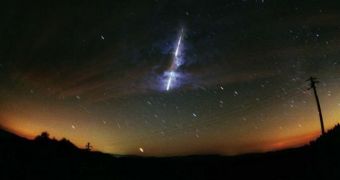Leonid Meteor Shower is associated with the comet Tempel-Tuttle. The event gets its name from the region of the sky, from which the meteors seem to radiate, since they stream down to Earth from a single point. The meteor shower takes place every year around the date of 17th of November, plus or minus a week, when the Earth's orbit intersects the stream of meteoroid particles, left behind by the passages of the comet.
The Leonid Meteor Shower is usually considered a spectacular event, but this year the display is expected to be rather modest. Nevertheless the viewing circumstances will be exceptional, due to the fact that the Moon will be in the first quarter and will set long before the constellation Leo climbs high in the sky.
The comet which triggers this spectacular event, Tempel-Tuttle, periodically comes through the inner solar system every 33.25 years, leaving behind a trail of fine dust particle, through which Earth passes every year in the middle of November. Since the cloud of dust is dispersed over a large region of space, in some years Earth might pass through a more concentrated dust filament, creating a meteor shower of thousands of meteors per hour, such as the display in the years 1999, 2001 and 2002, due to the passing of the comet in 1998.
Since 1998 the comet, thus the dense trail of dust, has fallen away from Earth's orbit, right back into the regions of the outer solar system, therefore the chance of high meteor activity is slim. Astronomers at the Royal Astronomical Society of Canada, estimated that the peak of meteor activity associated to the Leonid Meteor Shower will take place on the 17th of November, at 11 p.m.
At that particular moment, the Earth's orbit will be closest to the orbit of the comet and will have most chances of encountering debris from the comet. Due to the time at which the meteor shower is most probable to take place, the best places to view it will be on the African and European continent and on areas over the North American continent, later that night.
Researchers say that the meteor shower is unlikely to produce more than 15 meteors per hour, but they have also drawn the attention that in the night following the peak activity, some remaining matter from the passing of the comet back in the 1932 will probably produce some interaction with the Earth's atmosphere that will result in a brief bevy of about 30 to 60 meteors per hour.
Though the meteor shower emerges from the region of the sky near the constellation of Leo, astronomers advise the viewers not to concentrate only in that area but rather scatter in different regions of the sky. The best time to view it will be after midnight, when the observers will be exactly on the backside of the Earth in its orbit around the Sun.
The only meteors that will not fall on Earth will be those moving in the same direction as the Earth and have speeds greater than the speed of the planet on orbit, about 30 kilometers per second. Generally the Leonid meteorites move in the opposite direction of the Earth's orbit, hitting the atmosphere at speeds of about 72 kilometers per second and light up due to the friction with the air, producing long trails in their trajectory.

 14 DAY TRIAL //
14 DAY TRIAL //